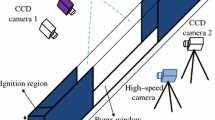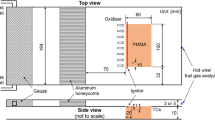Abstract
Long-distance petroleum or oil pipelines and aircraft taking off and landing cover a wide range of altitudes in practice. An increase in altitude leads to a decline in atmosphere pressure, as well as a decrease of the partial pressure of oxygen, which may influence the burning behavior of liquid fuels involved in accidental spills. In order to gain understanding on the hazards of spills from aircraft tanks or oil transport networks, experimental work was conducted in Hefei (50 m) and Lhasa (3,650 m) to investigate the effect of initial fuel temperature on flame spread over aviation kerosene both in low- and high-altitude environments. Data shows that flame spread is faster as the initial temperature increases. The transition from liquid-phase to gas-phase-controlled flame spread occurred at the initial fuel temperature of 65°C in Lhasa, but 82.5°C in Hefei. Moreover, for the same initial fuel temperature and under the regime controlled by liquid-phase transport, the rate of flame spread and temperature rise at low altitudes were smaller than those at higher altitudes, while the subsurface convection length and preheating time were larger. Direct evidence was also obtained to show the flame at both altitudes propagated in a pulsating forward-back-forward manner, whereas the average flame pulsation wavelength and frequency at the high altitude were larger than at the low altitude. Theoretical analyse predicts that an increase in initial fuel temperature or altitude led to an increase in fuel evaporation rate, which enhances flame spread and causes unsteady behavior. Given the difference in flame speed, fire accidents at high altitude are potentially more hazardous than those at low-altitude environment.










Similar content being viewed by others
References
Nagase K, Funatsu K (1990) A study of a fire on a diesel railcar. Fire Technol 26(4):290–309. doi:10.1007/bf01293075
Glassman I, Dryer FL (1981) Flame spreading across liquid fuels. Fire Saf J 3(2):123–138. doi:10.1016/0379-7112(81)90038-2
Akita K (1973) Some problems of flame spread along a liquid surface. Proc Combust Inst 14(1):1075–1083. doi:10.1016/s0082-0784(73)80097-9
Degroote E (2007) Control parameters of flame spreading in a fuel container. J Therm Anal Calorim 87(1):149–151. doi:10.1007/s10973-006-7838-1
Cai J, Liu F, Sirignano WA (2003) Three-dimensional structures of flames over liquid fuel pools. Combust Sci Technol 175(11):2113–2139. doi:10.1080/714923188
Takahashi K, Kodaira Y, Kudo Y, Ito A, Saito K (2007) Effect of oxygen on flame spread over liquids. Proc Combust Inst 31:2625–2631. doi:10.1016/j.proci.2006.07.196
Burelbach JP, Epstein M, Plys MG (1998) Initiation of flame spreading on shallow subflash fuel layers. Combust Flame 114(1–2):280–282. doi:10.1016/s0010-2180(97)00290-3
Elam SK, Altenkirch RA, Saito K (1990) Design of a radiant “Strip” heater for simulating liquid fuel flows in flame spreading. Fire Technol 26(2):156–168. doi:10.1007/bf01040180
Degroote E (2006) Fire safety on fuel containers. J Therm Anal Calorim 84(1):67–70. doi:10.1007/s10973-005-7174-x
Degroote E, Ybarra PLG (2005) Flame propagation over liquid alcohols: Part III. Pulsating regime. J Therm Anal Calorim 80(3):555–558. doi:10.1007/s10973-005-0693-7
Degroote E, Garcia-Ybarra PL (2000) Flame spreading over liquid ethanol. Eur Phys J B 13(2):381–386. doi:10.1007/s100510050045
Patej S, Plourde F, Kim SD, Hennequin D (2002) Vortex structure in a liquid film in the pulsating flame spread regime. Eur Phys J B 140:131–140. doi:10.1051/epjap
Higuera FJ (2002) Liquid-fuel thermocapillary flow induced by a spreading flame. J Fluid Mech 473:349–377. doi:10.1017/S0022112002002471
White D, Beyler CL, Fulper C, Leonard J (1997) Flame spread on aviation fuels. Fire Saf J 28(1):1–31. doi:10.1016/s0379-7112(96)00070-7
Guo J, Lu S, Zhou J, Wang C (2011) Effect of initial temperature on flame spread over aviation kerosene. J Combust Sci Tech 17(2):165–169
Zhou J, Chen G, Li P, Chen B, Wang C, Lu S (2010) Analysis of flame spread over aviation kerosene. Chin Sci Bull 55(17):1822–1827. doi:10.1007/s11434-010-3014-x
Konishi T, Tashtoush G, Ito A, Narumi A, Saito K (2000) The effect of a cold temperature valley on pulsating flame spread over propanol. Proc Combust Inst 28:2819–2826. doi:10.1016/S0082-0784(00)80704-3
Ross HD, Miller FJ (1998) Flame spread across liquid pools with very low-speed opposed or concurrent airflow. Proc Combust Inst 27:2723–2729. doi: 10.1016/S0082-0784(98)80128-8
Guo J, Lu S, Wang C (2013) Study on the subsurface flow induced by flame spread over aviation kerosene. J Therm Anal Calorim. doi:10.1007/s10973-013-3547-8
Wark K (1988) Generalized thermodynamic relationships, thermodynamics, 5th edn. McGraw-Hill, Inc., New York
Zhu F, Li K (2011) Numerical modeling of heat and moisture through wet cotton fabric using the method of chemical thermodynamic law under simulated fire. Fire Technol 47(3):801–819. doi:10.1007/s10694-010-0201-x
Jacob DJ (1999) Atmospheric pressure. In: Introduction to atmospheric chemistry: supplemental questions and problems, 4th edn. Princeton University Press, Princeton, p 12–20
Ross HD, Miller FJ (2000) Understanding flame spread across alcohol pools. Fire Saf Sci 6:77–94. doi:10.3801/IAFSS.FSS.6-77
Wu YC, Wu XC, Lu SX, Zhang JQ, Cen KF (2012) Novel methods for flame pulsation frequency measurement with image analysis. Fire Technol 48(2):389–403. doi:10.1007/s10694-011-0227-8
Ito A, Masuda D, Saito K (1991) A study of flame spread over alcohols using holographic interferometry. Combust Flame 83(3–4):375–389. doi:10.1016/0010-2180(91)90084-o
Rice OK (1947) The effect of pressure on surface tension. J Chem Phys 15(5):333–335. doi:10.1063/1.1746507
Hirano T, Suzuki T, Mashiko I, Tanabe N (1980) Gas movements in front of flames propagating across methanol. Combust Sci Technol 22(1–2):83–91. doi:10.1080/00102208008952373
Hassan MI, Aung KT, Faeth GM (1998) Measured and predicted properties of laminar premixed methane/air flames at various pressures. Combust Flame 115(4):539–550. doi:10.1016/S0010-2180(98)00025-X
Acknowledgment
The authors would like to thank the National Natural Science Foundation of China (No. 51036007) for its support. The authors also thank Ms. Geraldine Carton for her help with writing assistance.
Author information
Authors and Affiliations
Corresponding author
Rights and permissions
About this article
Cite this article
Li, M., Lu, S., Guo, J. et al. Initial Fuel Temperature Effects on Flame Spread over Aviation Kerosene in Low- and High-Altitude Environments. Fire Technol 51, 707–721 (2015). https://doi.org/10.1007/s10694-014-0395-4
Received:
Accepted:
Published:
Issue Date:
DOI: https://doi.org/10.1007/s10694-014-0395-4




